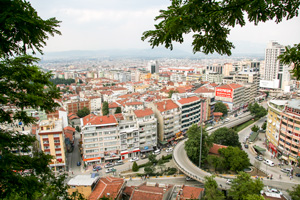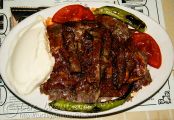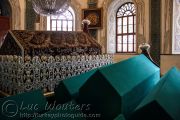Bursa is the second most populous city of the Marmara Region after Istanbul and the fourth most populous city in Turkey. It is a modern industrial city built around the mosques and mausoleums from its past as the first capital of the Ottoman Empire.
History of Bursa
The history of Bursa goes back as far as 5,200 BCE. It was mentioned by Aristotle and Strabo as the Greek city of Cius. In 202 BCE, the King of Macedonia Philip V granted the city to Prusias, the King of Bithynia who rebuilt the city and named it Prusa, after himself. In 1326, after a siege of almost 9 years, Prusa surrendered to Osman I (Osman Gazi), the founder of the Ottoman dynasty, who made it his capital city. Since the Turkish language does not allow for complex onsets (i.e. sequences of two or more consonants at the beginning of words), Prusa was Turkified to Bursa.
Bursa was the capital city of the Ottoman Empire until 1363 when Edirne in East Thrace was conquered. Located on the Silk Road, Bursa remained an important spiritual and commercial centre in the Ottoman Empire.
Sights and Photos of Bursa
A good place to start exploring the historic centre of Bursa is at Gazi Orhan Parkı, also known as Koza Parkı, which is at the heart of the historic city. The park is a beautiful shady square with a fountain, benches, and cafés. On the Northside of the park is the entrance to the Koza Han, or Silk-Coccoon Hall, a two-storey complex that was built in 1490 when Bursa was the final stop on the Silk Road. The Koza Han houses several (reasonably priced) shops selling silk and luxury goods. On the ground level, there are tea gardens with in the middle a small mosque. Beyond the Koza Han is the covered bazaar with assorted shops that sell clothes, luxury goods, furniture, and the famous shadow theatre Karagöz puppets. The ideal place to shop for some authentic souvenirs.
A 10-minute walk from the Gazi Orhan Park is the former Jewish quarter on Sakarya Caddesi, a busy lane of fish restaurants where you can enjoy eating freshly caught turbot from the Sea of Marmara. Back to the park, the Çakır Ağa Hamamı on Atatürk Caddesi provides an authentic Turkish bathing experience. The hamam was built by Çakır Ağa, a police chief under Sultan Murad II. Following the Atatürk Caddesi takes us to the Cumhuriyet Alanı (Republic Square), popularly known as Heykel (Statue), with its large Atatürk Statue. Nearby Kebapçı İskender (İskender Tarihi Ahşap Dükkan, Ünlü Caddesi 7), is the place to taste Bursa's gastronomic speciality, the famous Iskender kebap. It is a stylish restaurant, run by the İskenderoğlu family descendants of Iskender, the 19th-century inventor of the dish. Iskender kebap consists of döner kebap prepared from thinly cut grilled lamb topped with hot tomato sauce over pieces of pita bread and generously slathered with melted sheep butter and yoghurt.
Here are some of the photos of historic Bursa, click on the thumbnails to see greater pictures.
https://www.turkeyphotoguide.com/bursa?tmpl=component&print=1&layout=default#sigProIdac661a134d
Back to the Gazi Orhan Parkı, on its Westside, the square is flanked by the Ulu Cami (Great Mosque), built between 1396 and 1399 by Yıldırım (Lightning) Bayezid I, the fourth sultan in the Ottoman dynasty. The Ulu Cami is Bursa's most dominant mosque in Seljuk-style. Sultan Bayezid (also spelt Beyazit) pledged to build twenty mosques when he would defeat the Crusaders in the battle of Nicopolis in today's Bulgaria. After his victory, however, he interpreted this promise as one mosque with twenty domes supported by twelve freestanding square pillars. It is still the largest and most ambitious Ottoman mosque of its time with a majestic looking interior.
Bursa's most spectacular imperial mosque, however, is undoubtedly the Yeşil Cami (Green Mosque). It was constructed by Sultan Mehmed I Çelebi between 1413 and 1423. It is located just across Gök Dere, one of the two streams that run through Bursa. The architecture of the mosque with its plan as a reversed T and its beautiful marble work around the central doorway signals a departure from the previous Seljuk architecture. The mosque was named for its interior decoration with greenish-blue tiles. Around the mosque is a complex consisting of a tomb, a medrese and a hospice.
Here are photos of Bursa's main mosques, click on the thumbnails to see greater pictures.
https://www.turkeyphotoguide.com/bursa?tmpl=component&print=1&layout=default#sigProId9e03ae1113
The site of Bursa's citadel and oldest neighbourhood, Tophane is also known as Hisar (Fortress) is located on a steep cliff that can be climbed via pedestrian ramps. On the way up, one passes the Saltanat Kapısı or Gate of the Rulers (Imperial Gate). The present construction dates from 2005, when it was rebuilt after having been demolished in 1904. On the summit, there is a park, Timurtaş Paşa Parkı with a six-storey clocktower, some cafes and a splendid view over the valley. The park also contains the tombs of the Sultans Osman and Orhan (Osman gazi ve Orhan gazi türbeleri). Both are built on top of an old Byzantine monastery Saint Elijah, which at the time was known as the Silvery Dome. Osman I Gazi was the founder of the Ottoman Empire, which was named after him and lasted for 600 years. He was buried here after the conquest of Bursa by his son Orhan in accordance with his last wish “to be laid to rest beneath the silver dome of Bursa.” The tomb was destroyed by an earthquake in 1855 and rebuilt in Ottoman Baroque style by Sultan Abdülaziz in 1863, at which time on the opposite side a separate shrine was constructed for Orhan.
Here are photos of Bursa's Tophane neighbourhood, click on the thumbnails to see greater pictures.
https://www.turkeyphotoguide.com/bursa?tmpl=component&print=1&layout=default#sigProId2c88c9bd6e
Construction of the Muradiye Külliyesi was begun by Sultan Murad II in 1424 and was the last imperial foundation in Bursa. The Muradiye mosque complex consists of a mosque and a cemetery with twelve historic tombs, including that of Murat II, which makes it an imperial mausoleum. After the burial ground of Eyüp Sultan in Istanbul, this is the graveyard with the greatest number of imperial tombs. The earliest tomb was built in 1449 by Sultan Murad II for his wife Hüma Hatun and the last tomb was erected by Sultan Selim II for Prince Mustafa, son of Sultan Süleyman the Magnificent. Some of the tombs are luxuriously decorated with Iznik tiles.
Here are photos of the Muradiye Complex, click on the thumbnails to see greater pictures.
https://www.turkeyphotoguide.com/bursa?tmpl=component&print=1&layout=default#sigProId89f117cbf5
Travel Information & Travel Tips
There is a fast catamaran "sea bus" ferry boat that departs from the Yenikapı ferry boat terminal in Istanbul to Yalova (2 hrs). In Yalova buses are waiting which take you to the Bursa Otogar (about 1 hr). From there you can take a shuttle bus (minibus) or private taxi to the city centre. I've visited Bursa on several occasions and prefer to stay at the Artıç Hotel, which is centrally located, opposite the Gazi Orhan Parkı, and has decent rooms at reasonable prices. You need at least a day to visit most of the city's historic landmarks. Most tourists spend two nights in Bursa.






























































